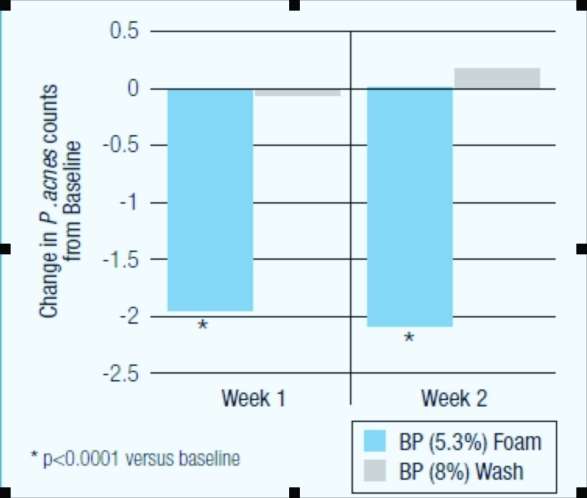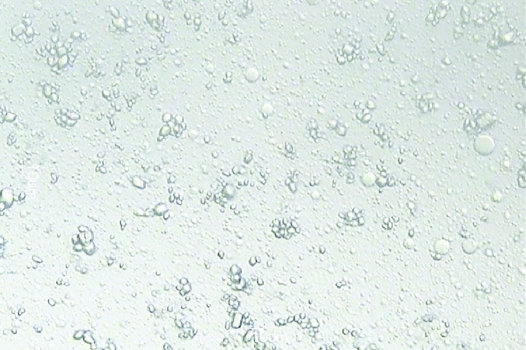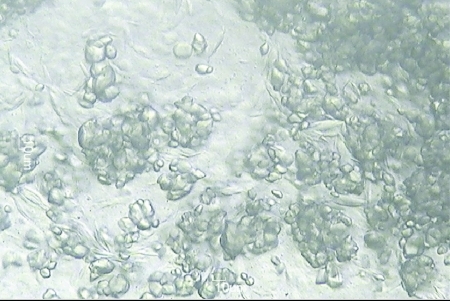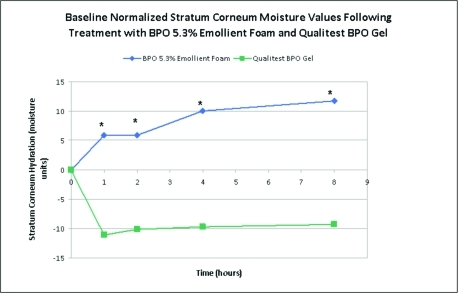Abstract
This article reviews findings of studies regarding the treatment of truncal acne with benzoyl peroxide formulations and, in particular, studies utilizing a 5.3% benzoyl peroxide foam. Its formulation of micronized benzoyl peroxide particles in an emollient foam vehicle offers significant clinical and bioavailability advantages that enhance follicular penetration and skin moisturization. A key consideration for topical management of truncal acne is whether the treatment application method allows adequate skin contact time to reduce Propionibacterium acnes colony counts. The foam formulation has demonstrated significant reduction in Propionibacterium acnes on the back when used either as a leave-on or as short-contact therapy for five minutes. Short-contact therapy with a benzoyl peroxide foam is a novel approach to minimize the risk of benzoyl peroxide bleaching of clothing in truncal acne patients.
Truncal acne vulgaris, defined as acne on the back or chest, is a common finding in dermatological practice. Yet despite its high clinical prevalence, there are few published data on its prevalence, grading, and management. In a United States community-based study by Del Rosso et al of topical and systemic management of truncal acne, the prevalence in male and female individuals was found to be 54 and 43 percent, respectively.1 A Canadian study of truncal acne prevalence in 965 referral patients with acne found a prevalence of 92 percent on the face and 45 and 61 percent on the chest and back, respectively.2 In a population-based study of 696 patients with acne vulgaris at five private practices in the United States between July and November 2006, 47.6 percent of patients had facial acne only while 52.3 percent had both facial and truncal acne. Only 2.3 percent presented with truncal acne only.
Truncal acne often goes unmentioned by patients presenting for treatment of facial acne. It is likely that truncal acne is under-diagnosed and under-treated. In one study, 78 percent of patients with truncal acne stated that they were definitely interested in being treated for it even though they had not voluntarily mentioned truncal involvement as part of their complaint.3
Follicular macular atrophic scarring is common in truncal locations and may present a significant cosmetic issue.1,4 Truncal scarring was observed in 10.6 percent of the patients in the community-based study cited above.3 As treatment for truncal scarring is ineffective, it is essential to detect and manage truncal acne to prevent the development of scarring.
Challenges of Treating Truncal Acne
The management of truncal and facial acne are similar with regard to effective agents. However, the large body surface areas over which truncal acne typically occurs renders topical treatment more challenging. It is important to select a lubricious formulation that can be applied easily on hairy and difficult-to-reach areas of the trunk or back.5
As with facial acne, the standard of care is the use of combination therapy that addresses as many of the four acne pathogenetic factors as possible and minimizes the likelihood of bacterial resistance developing.6,7 Topical treatment alone or a combination of topical and systemic antibiotic therapy should be employed for mild-to-moderate truncal acne.6 The decreasing sensitivity of Propionibacterium acnes to antibiotics has led to strategies to preserve utility in this disease. Benzoyl peroxide (BPO) optimizes “efficacy and mitigates the emergence of less sensitive P. acnes strains.”8 P. acnes has never demonstrated resistance to BPO.6,9
BPO Monotherapy in Truncal Acne
BPO is a potent antimicrobial; its anti-propionibacterial activity has been shown to exceed that of prescription antibiotics.9 While the current trend is to combine BPO with retinoids or other medications with a different but complementary mode of action,6 BPO monotherapy is frequently employed, particularly in the form of washes.10 BPO washes have been shown to be efficacious in reducing P. acnes on the face only.11 Published data regarding the efficacy of any BPO formulation for managing truncal acne are extremely limited. Nevertheless, BPO washes are frequently recommended for use while showering due to ease of application to large areas and to minimize the potential for bleaching of clothing.4 However, there is some concern that washes may not provide sufficient contact time, particularly on the back where longer contact times are typically required.
Review of Studies of BPO 5.3% Emollient Foam
Recently, the anti-propionibacterial effects of a formulation of BPO in an emollient foam vehicle were compared to a BPO 8% wash in a five-week, open-label, single-center study by James Leyden, MD.12 Subjects were 20 healthy adults (≥18 years of age) with high P. acnes densities on their backs (≥10,000 colonies per cm2), but no clinical signs of acne. All subjects had to be willing to refrain from using topical antimicrobial products, such as shampoos, soaps, or acne preparations. Patients who exhibited acute or chronic skin disorders including eczema and psoriasis were excluded as were those who had used topical or systemic antibiotics within four weeks of study initiation and women planning pregnancy or who were pregnant or nursing.
Each subject was treated under supervision by a technician at the study center daily during the first two weeks. A cherry tomato-sized amount of BPO 5.3% foam (BenzEFoam [benzoyl peroxide] Emollient Foam, 5.3%, Onset Therapeutics, Cumberland, Rhode Island) was applied to the area from just below the scapulae to the shoulders. After Week 2, application of the BPO foam was discontinued for one week to allow P. acnes regrowth. Beginning Week 4, subjects were instructed to apply a BPO 8% wash (Brevoxyl-8 [benzoyl peroxide] 8% Acne Wash Kit, Stiefel, a GSK Company, Duluth, Georgia) to the same area when showering, washing until a lather developed, rinsing, and patting dry. The wash was applied once daily during the first week and once or twice daily during the second week, depending on how frequently patients showered. Subjects were not instructed as to the amount of wash to apply.
The mean P. acnes count at baseline was log (base 10) 6.43±0.27 per cm2. One week of treatment with the BPO 5.3% emollient foam yielded a 1.93 log reduction in P. acnes counts and a 2.1 log reduction after two weeks. There was no reduction in P. acnes counts after treatment with the BPO 8% wash (Figure 1).
Figure 1.
Change from baseline in P. acnes counts with BPO 5.3% foam and BPO 8% wash
No serious adverse events were reported with either the BPO 5.3% emollient foam or the 8% wash, and there was no erythema, dryness, scaling, or burning either reported or observed. Three subjects experienced transient mild itching, and one subject experienced transient mild-to-moderate itching during treatment with the BPO 5.3% emollient foam.
Leyden noted that the lack of response to the 8% BPO wash on the back was surprising and was not likely due to poor adherence with at-home usage due to the lack of response in all subjects as opposed to response in some and failure in others. It is unlikely that an entire panel would have failed to adhere to instructions. The author suggests, therefore, that the brief skin contact time with the wash-off product may not have been sufficient for adequate deposition and penetration of the BPO. The reduced density of follicles and lipids on the trunk, compared to the face, may be insufficient for solubilization of BPO particles in suspension in the wash.
Leyden tested this hypothesis with a further study with a longer period of time between BPO application and rinsing. In a pilot study of six patients colonized with P. acnes on the back, 5.3% emollient foam was applied to the back and rinsed off after five minutes. Each subject was treated under supervision by a technician at the study center for five days, followed by two days of at-home treatment, followed by one more day of treatment at the study center for a total of eight days of treatment. Quantitative bacteriological cultures were obtained at Day 9. A 0.6 log10 cfu per cm2 mean reduction was found after eight daily treatments (p<0.05). The BPO foam demonstrated a significant reduction in P. acnes on the back when it was washed off after five minutes of skin contact.13
Studies Examining Characteristics of BPO 5.3% Emollient Foam
BPO particle size. BPO formulations may contain a range of particle sizes. BPO is often micronized so as to produce a consistent particle size. Micronized BPO particles that are smaller than the follicular orifice (~10µm) penetrate the pilosebaceous unit more effectively. Because BPO is poorly soluble in water, BPO molecules frequently cluster together and crystallize. This reduces bioavailability as many of the BPO molecules become trapped and unavailable in the center of the clusters. Clusters may also be larger than the follicular opening and thus less able to penetrate the follicle. A smaller BPO particle size may enhance anti-acne efficacy by enhancing bioavailability and enhancing intra-follicular penetration of the BPO active.
Specimens of BPO 5.3% emollient foam and a generic version of BPO cleanser (Oscion BPO 6%) were examined using the Motic Digital Microscope at 400x magnification. Figure 2A shows the BPO 5.3% emollient foam at 400x magnification. The average size of its crystalline BPO particles was 4.6µm. The particles were uniformly dispersed throughout the product with visible signs of small aggregates of approximately 20µg.
Figure 2A.
BPO 5.3% (400x magnification)
In contrast, the size of the crystalline particles of BPO in the generic cleanser varies from small (<10µm) to large (20–30µm), which indicates a broad particle size distribution. The small and large BPO crystals appear to be present at equal concentrations and not uniformly dispersed throughout the formulation. The product shows visible signs of BPO crystal aggregation and some of the large aggregates can easily be seen with the naked eye as white “specs” that are approximately 100x100µm. (Figure 2B).13
Figure 2B.
BPO 5% cleanser—generic (400x magnification)
Skin moisturization study. A study utilizing corneometry compared the skin moisturizing ability of BPO 5.3% emollient foam and a generic version of a BPO 5% gel. The study enrolled 10 adult subjects with no known sensitivity to any ingredients contained in the test products, with no medical or skin condition and no visible cuts or wounds on the volar forearms. At baseline, the moisture content of three test areas on the volar surfaces of both arms was measured using the MoistureMeter SC (Delfin Technologies, Ltd). Then, 400mg of the test articles were applied and moisture was measured at 1, 2, 4, and 8 hours post-application.
At all time points following application, BPO 5.3% emollient foam produced a statistically significant increase in skin moisturization values (p<0.05) compared to the generic version of BPO 5% gel (Figure 3). This finding suggests that the BPO 5.3% foam may mitigate or eliminate common BPO side effects, such as local irritation, dryness, and peeling. The generic BPO 5% gel actually produced a statistically significant decrease in skin moisture.13
Figure 3.
Baseline normalized stratum corneum moisture values following treatment with BPO 5.3% emollient foam and generic BPO 5% gel
Photographic results of BPO 5.3% emollient foam. A 17-year-old Caucasian boy presented with a 2- to 3-month history of acne vulgaris of the face, chest, upper back, and shoulders that had been treated only with over-the-counter products. Upon examination, he was found to have multiple 1 to 2mm lesions on the affected areas. There was no evidence of nodules or scarring but the patient did exhibit postinflammatory erythema on the upper back and shoulders. He was diagnosed with acne vulgaris (Figure 4A).
Figure 4A.
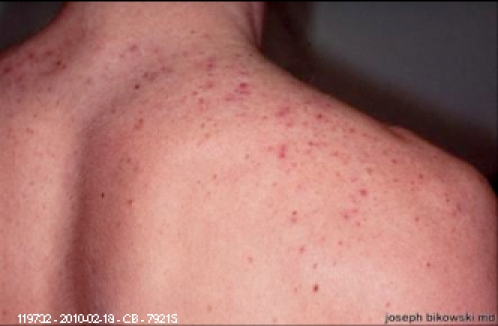
Subject at baseline
The patient was prescribed a mild cleanser and moisturizer to be used only on the face and BPO 5.3% foam to be applied twice daily to the face, chest, upper back, and shoulders. At the one-month follow up, there was a 75-percent reduction from baseline in inflammatory lesions of the face, chest, back, and shoulders. Some postinflammatory erythema persisted on the face and upper back, but there was no evidence of scarring (Figure 4B).
Figure 4B.
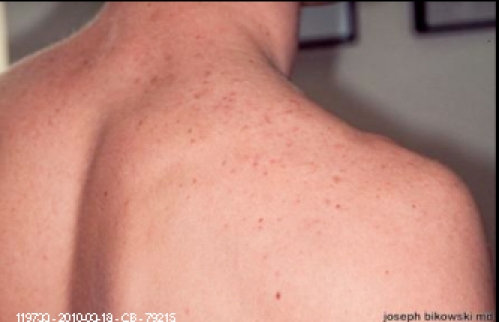
Subject one month post-treatment with BPO 5.3% foam
Summary
The BPO 5.3% emollient foam appears to be an effective and well-tolerated versatile formulation. It is very effective in reducing P. acnes on the back when used as leave-on therapy. Also, it is effective in reducing P. acnes as short-contact therapy and may be used to minimize the potential for bleaching of clothing. BPO 5.3% emollient foam is alcohol-free and has been shown to increase skin moisturization as measured by corneometry. In addition, its uniform small particle size may enhance the bioavailability and intra-follicular penetration of BPO, which could be expected to maximize antipropionibacterial efficacy.
BPO 5.3% emollient foam appears to be a useful new entrant into the acne treatment arsenal and may have particular utility in truncal acne. BPO 5.3% emollient foam is suitable for treating a large area, addresses the need for increased skin contact time on the back in comparison with the face, and offers an approach to minimizing the potential for bleaching of clothing through short-contact therapy.
References
- 1.Del Rosso JQ. Management of truncal acne vulgaris: current perspectives on treatment. Cutis. 2006;77(5):285–289. [PubMed] [Google Scholar]
- 2.Tan JK, Tang J, Fung K, et al. Prevalence and severity of facial and truncal acne in a referral cohort. J Drugs Dermatol. 2008;7(6):551–556. [PubMed] [Google Scholar]
- 3.Del Rosso JQ, Bikowski J, Baum E. Prevalence of truncal acne vulgaris: a population study based on private practice experience. Poster presented at: 65th Annual Meeting of the American Academy of Dermatology; February 2-6, 2007; Washington, DC.
- 4.Del Rosso JQ. Therapeutic cleansers: keeping it clean. Skin & Aging. 2003;11:83–88. [Google Scholar]
- 5.Del Rosso JQ. Pharmacotherapy update: managing truncal acne vulgaris. Skin & Aging. 2005;13(8):66–71. [Google Scholar]
- 6.Gollnick H, Cunliffe W, Berson D, et al. Management of acne: a report from a global alliance to improve outcomes in acne. J Am Acad Dermatol. 2003;49(1 Suppl):S1–S37. doi: 10.1067/mjd.2003.618. [DOI] [PubMed] [Google Scholar]
- 7.Thiboutot D, Gollnick H, Bettoli V, et al. New insights into the management of acne: an update from the global alliance to improve outcomes in acne group. J Am Acad Dermatol. 2009;60(5 Suppl):S1–S50. doi: 10.1016/j.jaad.2009.01.019. [DOI] [PubMed] [Google Scholar]
- 8.Leyden JJ, Del Rosso JQ, Webster GF. Clinical considerations in the treatment of acne vulgaris and other inflammatory skin disorders: focus on antibiotic resistance. Cutis. 2007;79(6 Suppl):9–25. [PubMed] [Google Scholar]
- 9.Kligman AM. Acne vulgaris: tricks and treatments. Part II. The benzoyl peroxide saga. Cutis. 1995;56(5):260–261. [PubMed] [Google Scholar]
- 10.Tanghetti E, Popp K. A current review of topical benzoyl peroxide: new perspectives on formulation and utilization. Dermatol Clin. 2009;27(1):17–24. doi: 10.1016/j.det.2008.07.001. [DOI] [PubMed] [Google Scholar]
- 11.Leyden JJ, Wortzman M, Baldwin EK. Antibiotic-resistant Propionibacterium acnes suppressed by a benzoyl peroxide cleanser 6% Cutis. 2008;82(6):417–421. [PubMed] [Google Scholar]
- 12.Leyden JJ. Efficacy of benzoyl peroxide (5.3%) emollient foam and benzoyl peroxide (8%) wash in reducing Propionibacterium acnes on the back. J Drugs Dermatol. 2010;9(6):622–625. [PubMed] [Google Scholar]
- 13.Data on File. Cumberland, RI: Onset Therapeutics; 2010. [Google Scholar]



